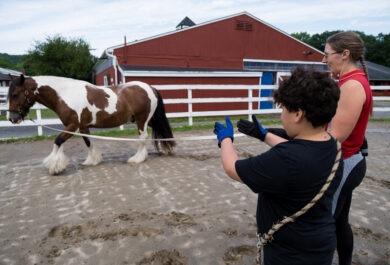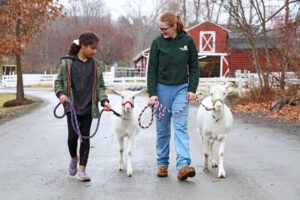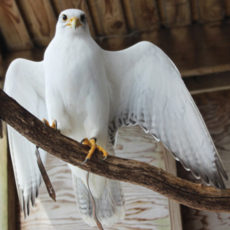Announcements

The term “pet therapy” was first coined in April 1964 by Psychologist Dr. Boris Levinson in a paper published in the journal Mental Hygiene. Dr. Levinson had incorporated his dog, Jingles, into therapy sessions with clients and documented the positive effects of the interactions. At the time, the very notion of incorporating contact with animals in human service settings was a novelty but in the decades that followed, new taxonomy developed to describe different activities.
In the 1980s, the Delta Society designated Animal-Assisted Therapy and Animal-Assisted Activities as key terminology. The first term defined an interaction with a specially trained animal conducted by a licensed health care professional as part of their client treatment, while the second term described a beneficial activity guided by a person and animal with special training. Outside clinical circles, Animal-Assisted Therapy became an umbrella term to describe any Human-Animal Interaction in health care settings, regardless of the credential of the person leading the interaction. Therapists saw their clinical work as diminished and, service providers began claiming to offer therapy without an associated license, inadvertently misrepresenting their qualification to provide such a service.
As the number of health care professionals, animal handlers and volunteers incorporating animals in activities increased, multiple special interest associations developed internationally. Occupational, physical, speech, recreation, play and mental health therapists all incorporated companion animals, horses or farm animals in their work with populations ranging from children to people with varied disabilities and health challenges to incarcerated individuals to hospice care patients. The role of dogs, horses and other animals supporting human health expanded and multiple terms emerged – Zoo Therapy; Riding for the Handicapped; Animal-Assisted Interventions; Equine-Facilitated Mental Health; Animal-Assisted Psychotherapy joined Animal Assisted Visitation; Hippotherapy; and other variations describing these forms of services came into use.
Frustrations in the field grew; the term “therapy” could not be an umbrella for any human service involving an animal. The absence of standard terminology made it challenging to define best practices, to gain recognition for valuable work and to describe services clearly for the public. Practitioners struggled to accurately code for insurance to obtain reimbursement for services. The lack of universal language also challenged scientists publishing research data, complicated literature searches, and hindered acceptance of research. The need for more aligned terminology became increasingly urgent.
In 2019, representatives of the major equine-assisted services groups published “Optimal Terminology for Services in the United States That Incorporate Horses to Benefit People: A Consensus Document.” Five years later, an international effort by a large number of professionals proposed an elegant terminology framework for all animal-assisted services with “Recommendations for Uniform Terminology in Animal-Assisted Services (AAS).” Although not binding or accepted by all representatives in the field, these significant steps in defining language by a credible and diverse core group of advocates and professionals provide clarity and continuity for establishing service standards and sharing evidence-based practices. While unresolved global terminology challenges remain – as direct translation of any framework from English is not always helpful, or possible, and there are regional differences in animal-assisted services – a new terminology baseline exists, and the evolution will continue.
 In the nature-based programs at Green Chimneys, this linguistic evolution has practical application. The term Animal-Assisted Services is now an accurate unifying term for all the various services that incorporate an animal in their work. Animal Assisted-Treatment best describes the work with our students done by psychologists and social workers, while Animal-Assisted Education encompasses psychosocial-emotional learning and humane education for children that integrates animals. As a community we can be clear about each activity; what credentials the facilitator must hold; what goals we set for the students; how we evaluate the service; and, equally important, how the role of the animal is defined to ensure optimal well-being for all.
In the nature-based programs at Green Chimneys, this linguistic evolution has practical application. The term Animal-Assisted Services is now an accurate unifying term for all the various services that incorporate an animal in their work. Animal Assisted-Treatment best describes the work with our students done by psychologists and social workers, while Animal-Assisted Education encompasses psychosocial-emotional learning and humane education for children that integrates animals. As a community we can be clear about each activity; what credentials the facilitator must hold; what goals we set for the students; how we evaluate the service; and, equally important, how the role of the animal is defined to ensure optimal well-being for all.
Green Chimneys’ founder Dr. Samuel “Rollo” Ross was a contemporary and friend of Boris Levinson and in 1964 Green Chimneys had already spent 20 years bringing children together with animals as part of their schooling. Both men are gone now, but the foundation they laid continues to inform the field of animal-assisted services. Today, these two visionaries would be strong advocates of the new terminology frameworks that clearly describe the many beneficial impacts animals can have on humans.
This content appeared in Institute Insights, the official newsletter of The Sam and Myra Ross Institute at Green Chimneys. The Ross Institute serves as a model and training site for the varied facets of human-animal and nature-based interactions, grounded in evidence-based practices for implementing diverse and ethically responsible educational and therapeutic interventions and activities.
Join the discussion and subscribe to Institute Insights >
